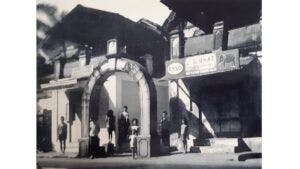A Tribute to Honesty: Memories of Another Mumbai
BOOKMARK
In the midst of one of the busiest shopping boulevards in suburban Mumbai stood an arch that honoured an upstanding citizen who lived there in quieter times. It might surprise you to know that the man it honoured was neither wealthy nor famous. He was a Customs employee, whose integrity impressed his superiors and colleagues so much that they pooled money to erect a commemorative arch with a touching citation right outside his house.
The man of the moment was Peter John Fonseca, a resident of Bandra and member of the Fonseca family, whose ancestry goes back more than 450 years. History has turned many a page since Fonseca’s impeccable honesty drew a just reward, for the Customs Department is no longer synonymous with adjectives that flatter.
So who was P J Fonseca and why should history remember him?
Fonseca was born on 8th December 1838, at Parvar, a tiny village in what is now the most sought-after address in Bandra, Pali Hill. The village doesn’t exist today; it is now a hill covered with highrises, a stark contrast to the hamlet where foxes and snakes once roamed freely.
Fonseca joined the Customs House in South Mumbai in 1858, as a lad of just 20. He worked his way up and retired as an Overseer in the Import Department. This was a time when the cotton textile industry was booming in India and trade in commodities such as opium, tobacco, sugar, spices and indigo too was thriving. This flourishing trade put considerable pressure on the Customs House in Bombay, the country’s commercial capital.
For lesser mortals who didn’t care much for their conscience, the Customs House offered rich pickings. Not for Fonseca, who had a knack for nosing out fraudulent transactions. He was recognised on several occasions for his diligence and unimpeachable ethics. Sample this from Customs records:
- In 1872, he pointed out to the Collector of Customs, attempts made by merchants to pass off spirits as products from oilmanstores (a company involved in the manufacture of food products & beverages)
- In 1873, he detected a fraud where cases of quinine were being passed off as cheese. The value of the confiscated property was then awarded to Fonseca as a reward by the Commissioner of Customs.
- In another incident, 330 cases of sporting gunpowder were being passed off as common powder. A report dated 29th June 1879, and made out by the Assistant Commissioner of Customs, stated: “Mr P J Fonseca, General Manifest Clerk, is the informant in this case by which the Customs Revenue has been saved a loss of four hundred and twenty-five rupees, six annas and two pies. Great praise is, I think, due to Mr P J Fonseca for having detected and brought to light this attempt to defraud the Customs Revenue. Had the present attempt escaped detention, it is hard to say how many more might have followed, entailing heavy losses of revenue. I am glad to be able to add that the informant in the present case has on previous occasions detected similar attempts to defraud the Customs Revenue.”
High praise, coming as it did from the top ranks and it also alluded to Fonseca’s track record in repeatedly “saving Customs revenue”.
Where and why was the arch built?
Fonseca worked in the Customs House for 42 years, which included an extension of service. He died on 4th December 1900, and just six days later, an order was passed for an arch to be built in his memory. It was erected on Hill Road, Bandra, on family property. While shops and restaurants have long since replaced the Fonseca home, the Tata Parsi Agiary, located diagonally opposite the erstwhile arch, still stands today.
Built from solid basalt, the arch was 12 to 15 feet tall. Just above the keystone, it supported a bust of P J Fonseca, sculpted in white marble and encased in basalt. The stones that supported the arch at either end were also made of white marble, no less.
– An inscription on the memorial read: “Erected to the memory of Mr Peter John Fonseca, a most patient, careful and trustworthy Overseer, Import Department, 25 years by his admirers and by Officers, Employees and Dalals of the Bombay Custom House, as a mark of the esteem.”
The inauguration of the arch was graced by H Crawford, Assistant Collector, Import Inspecting Department, in the presence of a select gathering consisting of Customs Officials, principal members of the East Indian community, to which Fonseca belonged, and the Fonseca’s family. D J Ferreira, Government nominee in the Legislative Council and the Bombay Municipal Corporation, said a few words, concluding with a couplet of the great English poet, Alexander Pope:
Honour and name from no condition rise.
Act well your part – there all the honour lies.
The arch was razed in the late 1970s by a real estate developer, who constructed a building where Fonseca’s home stood. Today, only its keystone remains, its message carried in the hearts of the Fonseca family but long forgotten in the Customs Department, where ‘honour once lay’.
Cover Image: A picture of the commemorative arch with members of P J Fonseca’s family gathered around it, on Hill Road, Bandra, in Bombay. This image was clicked in the 1970s, the decade when the arch was razed. Picture courtesy: Brian Fonseca










